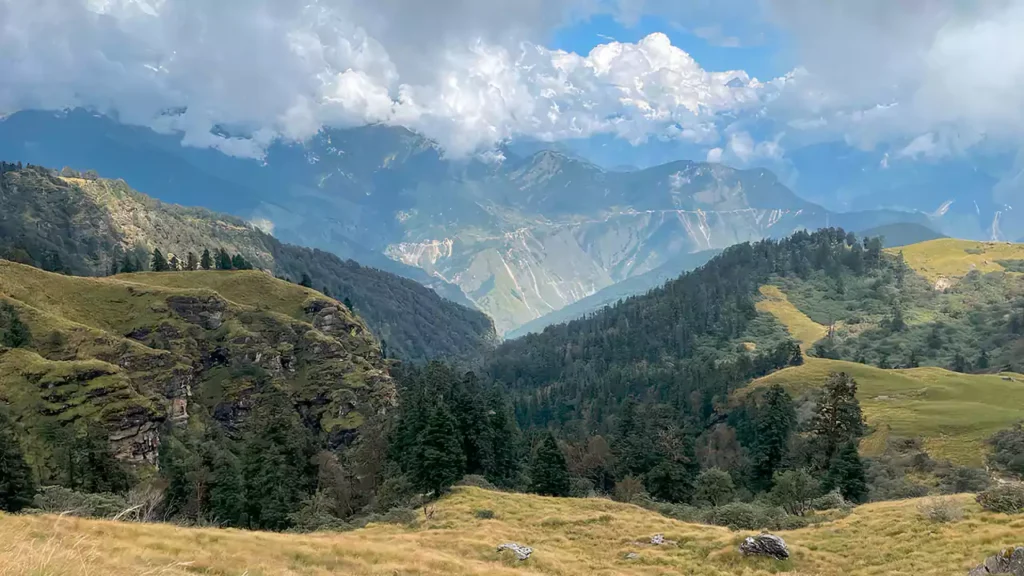Rudranath temple is the Fourth of Panch Kedar, a group of five sacred temples dedicated to Lord Shiva surrounded by the beautiful landscapes and Garhwal Himalayas located in Uttarakhand, India.
In Rudranath Temple Lord Shiva is worshipped as “Neelkanth Mahadev”.
Rudranath is the Fourth Kedar of Panch Kedar, where Lord Shiva’s face appeared.
In order to reach Rudranath Temple it passes through challenging terrain and it involves a 20Km trek passing through rhododendron forests and alpine meadows.
What is Panch Kedar?
The Panch Kedar is the group of five sacred Hindu temples of Lord Shiva located in the Garhwal Himalayas of Uttarakhand, India.
The temples of Lord Shiva, Panch Kedar was built by the Pandavas at each location after seeking his pardon and blessings.
Panch Kedar is the pilgrimage sites for devotees of Lord Shiva.
The five temples of Panch Kedar are Kedarnath, Tungnath, Rudranath, Madhyamaheshwar and Kalpeshwar.
Each temple of Panch Kedar holds immense significance in the Hindu mythology.
The temples of Panch Kedar are usually open for pilgrims during summers and where devotees from all the world come to take blessings, this is also the famous route of Char Dham Yatra.
History of Panch Kedar?
The Panch Kedar shrine or Panch Kedar, was established by the Pandavas.
The story behind this is that after the Mahabharata war, Pandavas wanted to atone for the killing of their brothers, family, and Brahmins. And for this, they went in search of Lord Shiva.
It is believed that Lord Shiva was angry with the Pandavas due to the Mahabharata war, so Lord Shiva took the form of a bull and believed hiding in an underground safe heaven in Guptkashi to escape from the Pandavas.
It is believed that even after this, Pandavas chased Shiva and later on Bhima recognized Shiva and tried to catch shiva.
Later Shiva’s body in the form of Bull’s body parts was rematerialized at five different locations.
Then it is said that five parts of Lord Shiva’s body appeared at five places which later came to be known as Panch Kedar.
Pandavas built the temples of Lord Shiva at each location.
Lord Shiva’s face appeared in Rudranath, while other parts like the hump in Kedarnath, Arms in Tungnath, Navel in Madhyamaheshwar, and Jata appeared in Kalpeshwar.
In this blog, I will take you to Rudranath temple, the fourth temple of holy Panch Kedar shrines.
How to Reach Rudranath Temple?

In order to reach Rudranath temple you have to reach Sagar Village which is also the base village for Rudranath, located in the Chamoli District of Uttarakhand.
You can reach Sagar village by car, which is just 3 km from Gopeshwar and at a distance of 22Km approx. from Nandaprayag which is also a part of sacred Panch prayag.
Sagar village is in the Garhwal region of Uttarakhand and is one of the beautiful locations known for its scenic beauty surrounded by Himalayas and forest and alpine meadows.
How to reach Sagar Village for Rudranath?
Sagar village is the base village of many treks.
By Bus
You can get ordinary bus from Delhi Kashmere Gate till Srinagar which is in Uttarakhand from there you can hire local buses or Taxi.
By Train
Nearest train station is Rishikesh which is 210Km approx.
By Air
Nearest Airport is Jolly Grant Airport, Dehradun from where Sagar village is 230n Km approx.
Stay overnight in Sagar village and start your trek early in the morning the next day to Rudranath temple.
Sagar village has a couple of homestays, hotels, and a few restaurants.
One can also arrange a porter and horse for the trek from this village.
Rudranath Temple Trek Itinerary
In order to reach the Rudranath temple you have to trek 20Km, though there are many trek routes that brings you to this temple.
As you start the trek, you will see farms of Sagar villagers, and in the next couple of minutes, you will find yourself deep in the rhododendron forests.
Punj Bugyal
The first alpine meadows, Pung Bugyal, greets you after a 4 km steep walk. From here, you can see several waterfalls on a nearby mountain, a sight that accompanies you in the following kilometers.
Moving forward from Pung Bugyal, you enter the lush green forests of the region, passing the waterfalls you saw earlier from Pung Bugyal. While you continue further, you will come across Ghimghima pani, Mauli Khark.
The trek is quite steep from Ghimghima Pani to Panar Bugyal.

The trek continues to Lwiti Bugyal, about 5-6 km from Pung Bugyal, where you’ll find 3-4 small tents for lunch and rest. The next meadow, Panar Bugyal, is around 2-3 km from Lwiti.
Panar Bugyal
The shops in these Bugyals also provide a stay facility at night, if you are tired, you can stay overnight and start fresh the next day.
Pitra Dhar
Pitra Dhar, the trek’s highest point at 13,100 ft, is the next destination, which is approximately 5-6 km from Panar Bugyal reaching Pitra Dhar marks the end of the challenging part of the trek, and from here, the trek becomes downhill.
The passage to Pitra Dhar is known for its beauty, marked by small stones stacked in memory of ancestors.
Peaks like Hathi Parvat, Mt. Nanda Ghanti, Mt. Nanda Devi, and Mt. Trishul become visible along the way.
Panch Ganga
Continuing further, you’ll arrive at Panch Ganga, the first water source since Panar Bugyal. A refreshing splash of cold water here helps relieve fatigue and motivates you to continue further.
A couple of minutes from Panch Ganga, you’ll catch the first glimpse of the holy Rudranath shrine.
After a few more kilometers, you’ll reach the shrine of Lord Rudranath, the culmination of this enchanting trek.
All about Rudranath Temple

Van Devta’s Temple is on one side of the main Rudranath Temple. Here, Van Devta, the forest deity, is worshiped before Lord Rudranath.
There are five small temples built on the right side of the temple, which are dedicated to the five Pandavas.
Saraswati Kund is located and is around 200-250 meters from the backside of Rudranath temple, The place is secluded and perfect for meditation. It is said that a long time ago, the tune of Goddess Saraswati’s Veena was heard here.
Lord Shiva’s Aarti is performed twice a day, The cheerful beats of the dhol and manjira, combined with Baba Rudranath Aarti, create a unique feeling of peace. This mix of traditional music and spirituality bring comfort and a sense of cultural connection.
If you believe in Lord Shiva, the morning Shringhar process of Lord Shiva’s idol is a no-miss.

Conclusion
In conclusion, if you are a devotee or travel enthusiast then the Rudranath should be on your travel bucket.
You want to know the circuit and latest update on Uttarakhand Tourism do visit https://uttarakhandtourism.gov.in/panch-kedar-circuit.
Happy traveling!
Frequently Asked Questions
-
Best time to visit Rudranath Temple?
The temple remains closed from November to April due to heavy snowfall. Pre-monsoon(April-May) and post-monsoon( August- October) seasons are the best times to visit Rudranath.
-
Is camping allowed in Rudranath?
The Chamoli forest department does not allow camping on the trek route. Travelers can stay in the available shared tents in Bugyal during the trek.
Be prepared as the facilities are limited, because of the location of the trek. -
How to Reach Sagar Village?
One can reach Sagar village by car or shared taxi, the distance of Sagar village from Rishikesh is approximately 220 km.
Route to follow, Rishikesh- Devprayag- Srinagar- Rudraprayag- Chamoli- Gopeshwar- Sagar Village.
-
Alternative routes to reach Rudranath Temple?
Travelers can choose from any of the three available trek routes to reach Rudranath.
Route 1( Most Preferred): Sagar Village- Pung Bugyal -Lwiti Bugyal -Panar Bugyal- Rudranath.
Route 2: Helam- Urgam- Dumak- Bansi Narayan- Panar Bugyal- Rudranath.
Route 3: Mandal Village- Anasuya Temple- Hansa Bugyal- Naola Pass- Rudranath. -
Things to carry with you on Rudranath Trek?
Essentials to include while preparing for the Rudranath trek are warm clothes, Sunscreen, Trekking Shoes, Water Bottle, and Raincoat.
-
what is the expected Cost of Rudranath Trek?
The cost of the Rudranath trek ranges from INR 7,000- INR 10,000. You can also connect with tour operators for a complete package.
Articles for you on Spiritual Journey
- Char Dham Yatra: Spiritual Journey of a Lifetime
- 12 Jyotirlingas in India – Sacred Shrines of Lord Shiva
- Panch Kailash – Sacred Spiritual Journey to 5 Kailash Peaks
- Panch Kedar: The 5 Sacred Shrines of Shiva
- Kasar Devi – Uttarakhand Meditation Hub UK01
- A Guide to the Panch Prayag of Uttarakhand
- Golu Devta: The God of Justice, Uttarakhand
- Ancient Vridh Kedar (Old Kedar ) Shiva Temple
- Jhula Devi Mata Temple, Ranikhet
- Ram Mandir Ayodhya – Complete Guide 2024
- Ram Lalla and Ram Mandir Ayodhya 2024
- Shrikhand Mahadev Yatra Registration: Your Comprehensive Guide
- Kainchi Dham Ashram Uttarakhand: Neem Karoli Baba Sacred Abode
- Kamakhya Temple, Guwahati: A Mystical World Of Tantra
- Rudranath Temple: Fourth Kedar In Uttarakhand
- Girija Devi Temple – Ramnagar, Uttarakhand UK19
- Uttarakhand Ancient Vridh Kedar – Shiv Temple
Joshi Milestoner is a website working continuously to deliver the best on travel, adventure and airports & aviation. Do not forget to read our blogs and for any queries you can write to us our team will be happy to help you.
Get notified of our blog post via email by subscribing to our Newsletter with the link provided below and do consider subscribing our YouTube channel (Joshi Milestoner) too for more you can follow us on Google News.
Affiliate Disclosure / Disclaimer: Blog Post on our website may contain affiliate links/ Banner. By Clicking and by purchasing the commission can be earned by us (at no extra cost to you) if you purchase anything through the links provided on this website.




